Above: Greater Dodder (Cuscuta europaea) © David Hall
Leader: Helena Crouch
On a scorching hot day, nine members met in a residential road near a large industrial estate at the edge of Bristol, to explore Eastwood Farm Local Nature Reserve. The reserve, a former dairy farm then municipal tip, nestles in a bend in the River Avon, where the river cuts through Pennant Sandstone. The site has a mix of habitats, including river bank, flood plains, pools, meadows and woodland.
We entered the reserve through woodland, where we spotted two Speckled Wood butterflies and a Small White. Descending towards the river, we reached a sheltered grassland glade, a species-rich remnant of the former pastures, with Knapweed and Yellow-rattle in flower. Here we saw Meadow Browns, Ringlets, a Gatekeeper and several Small Skippers and a Wren, and met two of the Friends of Eastwood Farm, who help manage the site.
The riverside grassland nearest the entrance was vibrant with hordes of youngsters and families enjoying the sun and river swimming, but away from this “honeypot” site the reserve is an amazingly tranquil, secluded spot.
Much of the floodplain supports a tall herb vegetation, with Nettles, Hogweed, Meadowsweet, Himalayan Balsam, Brambles and Creeping Thistle. Although botanically a little dull, this vegetation provides shelter and nectar sources for wildlife. A lagoon and pond add to the biodiversity.
The lagoon is largely choked by native Branched Bur-reed (Sparganium erectum), with a large patch of White Water-lily (Nymphaea alba) and smaller patches of Fringed Water-lily (Nymphoides peltata), both of which are introduced here. On the far side we spotted the attractive pink umbels of Flowering-rush (Butomus umbellatus). Two Mallards and a Moorhen were busy on the water and a Song Thrush was singing stridently.
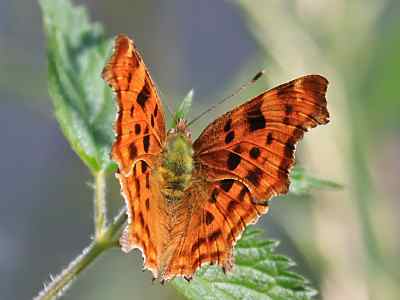
Comma © David Hall

Female Common Blue © David Hall
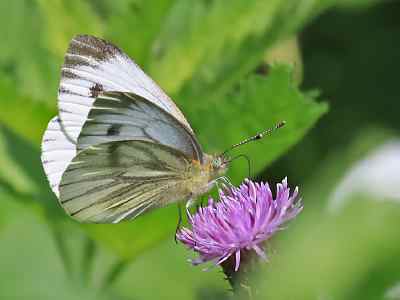
Green-veined White © David Hall
We saw a Peacock butterfly, a Comma and a Green-veined White, and Broad-bodied chasers and Common Darter as well as damselflies including Large Red ovipositing. The small pond had a convenient viewing platform, allowing us to study the dainty flowers of Water-plantain and watch Water Boatmen. The surface was covered with Great Duckweed, whilst the dominant submerged plant was Rigid Hornwort, but we also found Curled Pondweed.
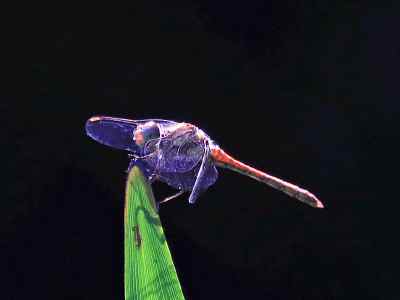
Common Darter © David Hall
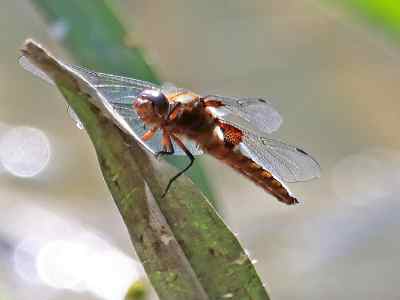
Broad-bodied Chaser © David Hall
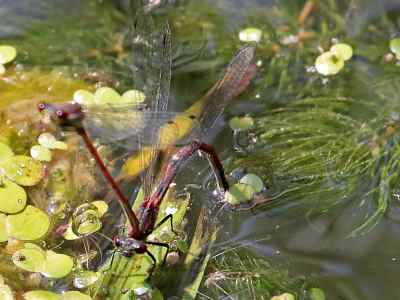
Large Red Damselfly ovipositing © David Hall
The riverbank was largely obscured by tall nettles, which we searched continuously for Greater Dodder, but in places we could view the river itself, where the native Yellow Water-lily (Nuphar lutea) was flowering and bearing flask-shaped fruits, which give it the colloquial name of Brandy-bottle. On the bank, we spotted a pretty yellow-flowered shrub, the Stinking Tutsan (Hypericum hircinum). This garden escape is turning up increasingly in the wild and although pretty, it certainly lives up to its name! Our record was the first for the 10km square since 1930.
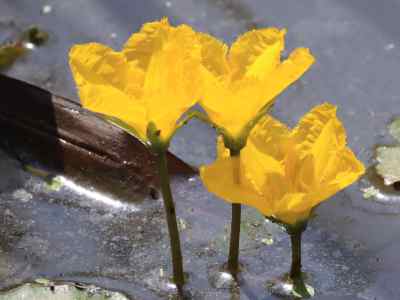
Fringed Water-lily (Nymphoides peltata) © David Hall
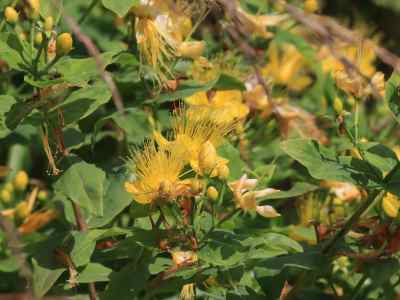
Stinking Tutsan (Hypericum hircinum) © David Hall
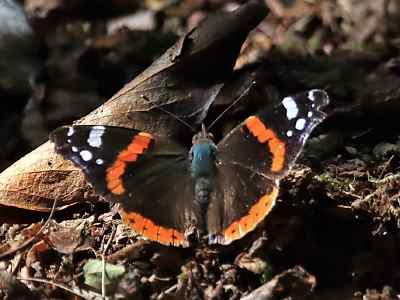
Red Admiral © David Hall
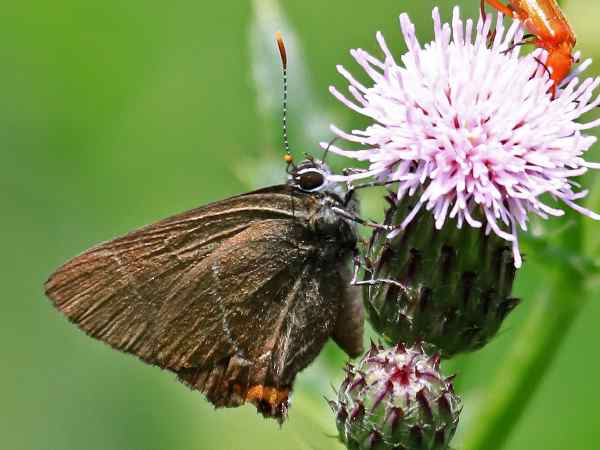
White-letter Hairstreak © David Hall
Two Jays, a Common Blue and a Red Admiral were seen by the riverbank, but it was on Creeping Thistles by the path that we made our most exciting find of the day. A small brown butterfly attracted our attention, rarely staying still for long, and never stopping with its wings open! With persistence, careful observation, and an identification chart, it turned out to be a White-letter Hairstreak, a new butterfly for many of us.
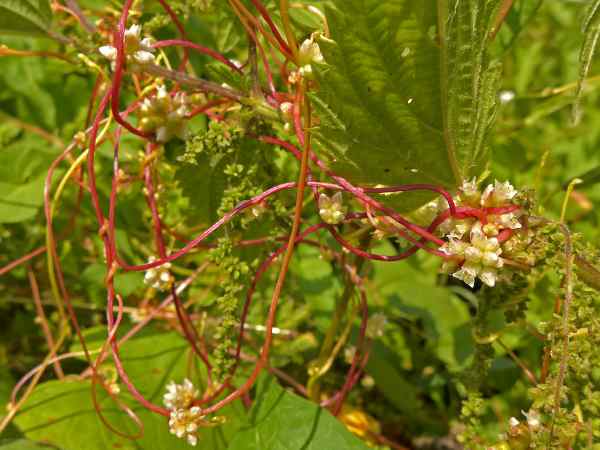
Greater Dodder (Cuscuta europaea) © Helena Crouch
On a patch of nettles by the river, we finally found some Greater Dodder (Cuscuta europaea) pictured left and top of page, with its red and yellow stems twining around the nettles, and clusters of little pink flowers. This wholly parasitic plant is an annual, growing on nettles or hops. It is found at sites along the River Avon, from Freshford through Bath, Saltford and Keynsham, with Eastwood Farm being its most westerly known site in England, apart from an isolated site at Muchelney on the Somerset Levels.
South of the reserve, the riverside path continues along the edge of ancient woodland, which cloaks the steep slopes. Bracken and large patches of Great Woodrush (Luzula sylvatica) indicate the acidic nature of the underlying rock. The shady riverbank was a perfect spot for lunch, during which we heard a Stock Dove and a Green Woodpecker and watched some quite large fish in the river. Appreciating the shade, we explored further along the narrow path, finding several species of fern and admiring a huge Wych Elm overhanging the river (the food plant of caterpillars of the White-letter Hairstreak).
In the river we spotted a fine-leaved pondweed, sadly inaccessible, and large clumps of the tall Common Clubrush (Schoenoplectus lacustris), formerly confusingly called Bulrush, the name by which many know the plant now called Reed-mace!
In the woodland we spotted Yellow Archangel, Wood Millet (Milium effusum) and Wood Melick (Melica uniflora) which, like the Great Woodrush and ferns, are Ancient Woodland Indicators. Retracing our steps and emerging from the cool wooded riverside path, the heat seemed intense, so we chose a path through woodland to return slowly to our cars. Despite this site being on the edge of a city, formerly farmland, and previously used as a tip, it is a surprisingly tranquil river valley with a good diversity of wildlife.
Helena Crouch


Recent Comments